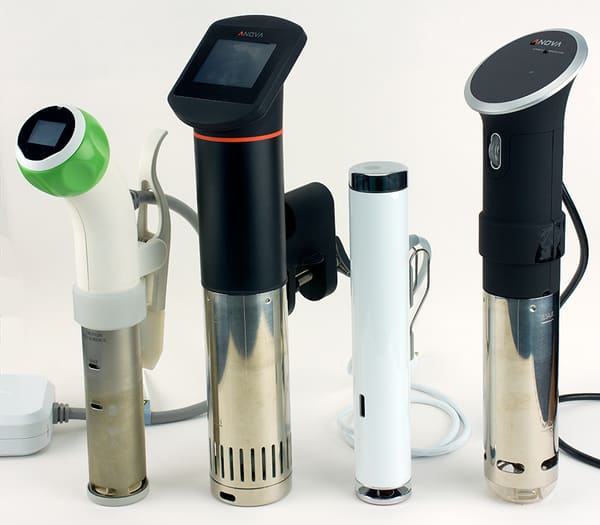-
Sous Vide Time and Temperatures
Sous Vide Time and Temps
Sous Vide Time and Temps
Sous Vide Temps
- All Sous Vide Temperatures
- Sous Vide Beef Temperatures
- Sous Vide Chicken Temperatures
- Sous Vide Duck Temperatures
- Sous Vide Fish Temperatures
- Sous Vide Vegetables Temperatures
- Sous Vide Infusions Temperatures
- Sous Vide Lamb Temperatures
- Sous Vide Pork Temperatures
- Sous Vide Shellfish Temperatures
- Sous Vide Turkey Temperatures
- Recipes Recipes Recipes Recipes
- Getting Started Guides Getting Started Guides Getting Started
- Equipment and Tools Equipment and Tools Equipment Equipment and Tools
- More Resources More Resources Resources More Resources
How Does the ChefSteps Joule Compare to Other Sous Vide Machines?
More Sous Vide Articles
•
Sous Vide Benchmarks • Sous Vide Equipment
Click here to get great sous vide content via email
This post may contain affiliate links. Read more.
Written by Jason Logsdon
There's been a whole lot of talk about ChefSteps' new Joule Sous Vide Immersion Circulator. Between the lack of a physical interface (hello, smartphone controls!) and the small size, there's a lot of talking points.
For me, the most important aspects are how well it heats the water, and how much noise does it make...hey, I live in a small New York apartment and even a little noise fills the whole place!
We decided to take the Joule and put it through our sous vide benchmark tests to see how well it compared to the other major brands out there. Spoiler alert...it did pretty dang good!

The first set of tests determine how quickly the circulator can heat the water. It went from room temperature to 140°F (60°C) in only 20 minutes and from hot tap water to 140°F (60°C) in just over 5 minutes.
Note: For the full numbers, you can view the entire sous vide benchmark results and for more information about the Joule itself, check out our detailed ChefSteps Joule Sous Vide Circulator review.
Even the time to rise from 140°F (60°C) to 183°F (83.89°C) was only 16 minutes. All of these times were within the top 3 fastest times for all inexpensive circulators, only being consistently beaten by the Gourmia Immersion Circulator Pod, which is still the fastest heating circulator we've tested. The Joule also used the least amount of power in the first hour of use, and the second least over the full two hours of the test.

At 140°F (60°C) the Joule only had a temperature fluctuation of 0.1°F and at 183°F (83.89°C) it was still only 0.2°F, tying it for the top spot in arguably the most important function a sous vide machine has.
On the sound test, probably the most important component to me, the Joule came in second, only being edged out slightly by the Sansaire Sous Vide Circulator. When measured next to the machine, the Joule only added about 4 dB above the room noise, compared to 2 for the Sansaire. Though once you got more than a foot away, both machines didn't show up above the ambient room noise.
All in all, from a performance perspective it was the only machine to finish in the top 3 of all the benchmark tests, which is a pretty mean feat! So if you don't mind the lack of a physical interface or paying a little more money, the Joule is a great choice for a sous vide machine.
Have you used the Joule? Got any opinions about it? Let me know in the comments!
 This article is by me, Jason Logsdon. I'm an adventurous home cook and professional blogger who loves to try new things, especially when it comes to cooking. I've explored everything from sous vide and whipping siphons to pressure cookers and blow torches; created foams, gels and spheres; made barrel aged cocktails and brewed beer. I have also written 10 cookbooks on modernist cooking and sous vide and I run the AmazingFoodMadeEasy.com website.
This article is by me, Jason Logsdon. I'm an adventurous home cook and professional blogger who loves to try new things, especially when it comes to cooking. I've explored everything from sous vide and whipping siphons to pressure cookers and blow torches; created foams, gels and spheres; made barrel aged cocktails and brewed beer. I have also written 10 cookbooks on modernist cooking and sous vide and I run the AmazingFoodMadeEasy.com website.
Affiliate Disclaimer: Some links on this site might be affiliate links that if used to purchased products I might receive money. I like money but I will not endorse something I don't believe in. Please feel free to directly go to any products I link to and bypass the referral link if you feel uncomfortable with me receiving funds.













